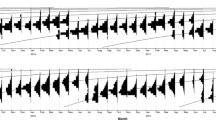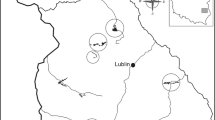Abstract
Most introduced non-native species fail to establish as a result of mortality or reproductive failure. An established population can increase the probability of survival and reproductive success of newly introduced individuals by reducing both Allee effects and demographic stochasticity. Previously, attention has been paid to the establishment phase of the invasion process and its probability modelled as a stochastic process, while the spread phase has received less attention. By analyzing data collected during the spread phase of an invasion of the round goby, Neogobius melanostomus, in Hamilton Harbour, Lake Ontario, we develop an analytical approach to backcalculate the time to establishment and to determine the time to habitat saturation. Our modelling shows that: (1) during the transition between arrival and establishment, propagule pressure in the form of new adults entering the area can be very low and still represent a significant probability of establishment; (2) much higher concentrations of juveniles would be needed to pose a significant risk of invasion; (3) the demographic contribution of propagule pressure during the spread phase is low and its total elimination will not halt population growth and spread; (4) a short elapsed time between arrival and establishment indicated that the transition between these two phases can be characterized as a deterministic process with high propagule pressure and low adult mortality rates; and, (5) very aggressive management actions would be needed to halt population growth after population establishment, suggesting that preventative measures are the most effective management options available to reduce risk of future invasions.





Similar content being viewed by others
References
Andersen MC, Adams H, Hope B, Powel M (2004) Risk assessment of invasive species. Risk Anal 24:787–793
Arim M, Abades SR, Neill PE, Lima M, Marquet PA (2006) Spread dynamics of invasive species. Proc Nat Acad Sci 103:374–378
Balshine S, Verma A, Chant V, Theysmeyer T (2005) Competitive interactions between round gobies and logperch. J Great Lakes Res 31:68–77
Bolger T, Connolly PL (1989) The selection of suitable indices for the measurement and analysis of fish condition. J Fish Biol 34:171–182
Bossenbroek JM, Nekola JC, Kraft CE (2001) Prediction of long-distance dispersal using gravity models: zebra mussel invasion of inland lakes. Ecol Appl 11:1778–1788
Bunnell DB, Johnson TB, Knight CT (2005) The impact of introduced round gobies (Neogobius melanostomus) on phosphorus cycling in central Lake Erie. Can J Fish Aquat Sci 62:15–29
Burnham KP, Anderson DR (1998) Model selection and inference: a practical information-theoretic approach. Springer, New York
Caswell H (2001) Matrix population models: construction, analysis, and interpretation. Sinauer Associates, Inc. Publishers, Sunderland, Massachusetts
Chant V (2002) Reproductive ecology and potential impacts of the invasive round goby (Neogobius melanostomus) in Hamilton Harbour. B. Sc. Dissertation. McMaster University, Hamilton, ON, Canada
Chapman DG, Robson DS (1960) The analysis of a catch curve. Biometrics 16:354–368
Charlebois PM, Marsden JE, Goettel RG, Wolfe RK, Jude DJ, Rudnika S (1997) The round goby, Neogobius melanostomus (Pallas). A review of European and North American literature. Illinois-Indiana Sea Grant Program and Illinois Natural History Survey, Illinois. INHs Special Publication No. 20
Charnov EL (1993) Life history invariants. Oxford University Press, Oxford
Chotkowski MA, Marsden JE (1999) Round goby and mottled sculpin predation on lake trout eggs and fry: field predictions from laboratory experiments. J Great Lakes Res 25:26–35
Corkum LD, Sapota MR, Skora KE (2004) The round goby, Neogobius melanostomus, an invader on both sides of the Atlantic. Biol Invasions 6:173–181
Corkum LD, Arbuckle WJ, Belanger AJ, Gammon DB, Li W, Scott AP, Zielinski B (2006) Evidence of a male pheromone in the round goby (Neogobius melanostomus). Biol Invasions 8:105–112
Dawson VK, Boogaard MA, Bills TD (1998) Evaluation of piscicides for controlling range expansion of round goby (Neogobius melanostomus) and ruffe (Gymnocephalus cernuus). United States Geological Survey, Biological Resources Division
de Kroon H, Plaisier A, Groenendael JV, Caswell H (1986) Elasticity: the relative contribution of demographic parameters to population growth rate. Ecology 67:1427–1431
Drake JM (2004) Allee effects and the risk of biological invasions. Risk Anal 24:795–802
Drake JM (2005) Risk analysis for species introductions: forecasting population growth of Eurasian ruffe (Gymnocephalus cernuus). Can J Fish Aquat Sci 62:1053–1059
Dubs DOL, Corkum LD (1996) Behavioral interactions between round gobies (Neogobius melanostomus) and mottled sculpins (Cottus bairdi). J Great Lakes Res 22:838–844
Eshenroder RL, Burnham-Curtis MK (1999) Species succession and sustainability of the Great Lakes fish community. In: Taylor WW, Ferreri CP (eds) Great lakes fisheries policy and management: a binational perspective. Michigan State University Press, East Lansing, pp 145–184
Fretwell SD, Lucas HL (1970) On territorial behavior and other factors influencing habitat distribution in birds. Acta Biotheor 19:16–36
Haccou P, Iwasa Y (1996) Establishment probability in fluctuating environments: a branching process model. Theor Popul Biol 50:254–280
Hensler SR, Jude DJ (2007) Diel vertical migration of round goby larvae in the Great Lakes. J Great Lakes Res 33:295–302
Hoover JJ, Adams SR, Killgore KJ (2003) Can hydraulic barriers stop the spread of the round goby? ANSRP Technical Notes Collection (TN ANSRP-03-1), U.S. Army Engineer Research and Development Center, Vicksburg, MS. www.wes.army.mil/el/ansrp
Janssen J, Jude DJ (2001) Recruitment failure of mottled sculpin Cottus bairdi in Calumet Harbor, Southern Lake Michigan, induced by the newly introduced round goby Neogobius melanostomus. J Great Lakes Res 27:319–328
Jensen AL (1996) Beverton and Holt life history invariants result from optimal trade-off of reproduction and survival. Can J Fish Aquat Sci 53:820–822
Jerde CL, Lewis MA (2007) Waiting for invasions: a framework for the arrival of nonindigenous species. Am Nat 170:1–9
Jude DJ (2001) Round and tubenose gobies: 10 years with the latest Great Lakes phantom menace. Dreissena 11(4):1–14
Jude DJ, Reider RH, Smith GR (1992) Establishment of Gobiidae in the Great Lakes Basin. Can J Fish Aquat Sci 49:416–421
Kuhns LA, Berg MB (1999) Benthic invertebrate community responses to round goby (Neogobius melanostomus) and zebra mussel (Dreissena polymorpha) invasion in southern Lake Michigan. J Great Lakes Res 25:910–917
Leung B, Drake JM, Lodge DM (2004) Predicting invasions: propagule pressure and the gravity of Allee effects. Ecology 85:1651–1660
Lockwood JL, Cassey P, Blackburn T (2005) The role of propagule pressure in explaining species invasions. Trends Ecol Evol 20:223–228
MacInnis AJ (1997) Aspects of the life history of the round goby, Neogobius melanostomus (Perciformes: Gobiidae) in the Detroit River. M.Sc. Dissertation, University of Windsor, Windsor, Ontario
MacInnis AJ, Corkum LD (2000a) Age and growth of round goby Neogobius melanostomus in the Upper Detroit River. Trans Am Fish Soc 129:852–858
MacInnis AJ, Corkum LD (2000b) Fecundity and reproductive season of the round goby Neogobius melanostomus in the Upper Detroit River. Trans Am Fish Soc 129:136–144
Mertz G, Myers RA (1996) Influence of fecundity on recruitment variability of marine fish. Can J Fish Aquat Sci 53:1618–1625
Miner JG, Farver JR (2004) Quantifying round goby dispersal mechanisms: impacts on mitigation efforts. Final Report for Lake Erie Protection Fund Grant, Sea Grant 185-02
Morris WF, Doak DF (2002) Quantitative conservation biology: theory and practice of population viability analysis. Sinauer Associates Inc, Sunderland, MA
Morrison HA, Whittle DM, Haffner GD (2000) The relative importance of species invasions and sediment disturbance in regulating chemical dynamics in western Lake Erie. Ecol Model 125:279–294
Nichols SJ, Kennedy G, Crawford E, Allen J, French J III, Black G, Blouin M, Hickey J, Chernyak S, Haas R, Thomas M (2003) Assessment of Lake Sturgeon (Acipenser fulvescens) spawning efforts in the lower St. Clair River, Michigan. J Great Lakes Res 29:383–391
Pimentel D, Lach L, Zuniga R, Morrison D (2000) Environmental and economic costs of nonindigenous species in the Unite States. Bioscience 50:53–65
Ray WR, Corkum LD (2001) Habitat and site affinity of round goby. J Great Lakes Res 27:329–334
Ricciardi A, MacIsaac HJ (2000) Recent mass invasion of the North American Great Lakes by Ponto Caspian species. Trends Ecol Evol 15(2):62–65
Roman J, Darling JA (2007) Paradox lost: genetic diversity and the success of aquatic invasions. Trends Ecol Evol 22:454–464
Roy R, Legendre P, Knowles R, Charlton MN (1994) Denitrification and methane production in sediment of Hamilton Harbour (Canada). Microb Ecol 27:123–141
Savino JF, Jude DJ, Kostich MJ (2001) Use of electrical barriers to deter movement of round goby. Am Fish Soc Symp 26:171–182
Shigesada N, Kawasaki K (1997) Biological invasions: theory and practice. Oxford University Press, Oxford
Simberloff D (2003) How much information on population biology is needed to manage introduced species? Conserv Biol 17:83–92
Stepien CA, Tumeo MA (2006) Invasion genetics of Ponto-Caspian gobies in the Great Lakes: a ‘cryptic’ species, absence of founder effects, and comparative risk analysis. Biol Invasions 8:61–78
Taylor CM, Norris R (2007) Predicting conditions for migration: effects of density dependence and habitat quality. Biol Lett 3:280–283
Thomas RW, Hugget RJ (1980) Modeling in geography. Barnes and Noble Books, Totowa, New Jersey
UOT (2010) Alarming invasion of round goby into Great Lakes tributaries: impact on endangered fishes. University of Toronto, ScienceDaily 7 September 2009. 24 April 2010 <http://www.sciencedaily.com−/releases/2009/08/090811143727.htm
Vanderploeg HA, Nalepa TF, Jude DJ, Mills EL, Holeck KT, Liebig JR, Grigorovich IA, Ojaveer H (2002) Dispersal and emerging ecological impacts of Ponto-Caspian species in the Laurentian Great Lakes. Can J Fish Aquati Sci 59:1209–1228
Vatland S, Budy P (2007) Predicting the invasion success of an introduced omnivore in a large, heterogeneous reservoir. Can J Fish Aquat Sci 64:1329–1345
Vermeij GJ (1996) An agenda for invasion biology. Biol Conserv 78:3–9
Von Holle B, Simberloff D (2005) Ecological resistance to biological invasion overwhelmed by propagule pressure. Ecology 86:3212–3218
Williamson MH, Fitter A (1996) The varying success of invaders. Ecology 77:1661–1666
Wolfe RK, Marsden JE (1998) Tagging methods for the round goby (Neogobius melanostomus). J Great Lakes Res 24:731–735
Young JAM, Marentette JR, Gross C, McDonald JI, Verma A, Marsh-Rollo SE, McDonald PDM, Earn DJD, Balshine S (2010) Demography and substrate affinity of the round goby (Neogobius melanostomus) in Hamilton Harbour. J Great Lakes Res 36:115–122
Acknowledgments
We also wish to thank an anonymous reviewer for his/her comments and suggestions. A large number of people helped collect the data for this study. We would like to thank. Julie Marentette, Susan Marsh Rollo, James McDonald, Aikta Verma, Caroline Gross, Natalie Sopinka, Claire Schiller, Krista Gooderham, Alyssa Schermel, Alix Stoic, Nikol Piskuric, Jennifer Beneteau, Chris Blanchard, Angie Buchner, Sandeep Mishra, Melanie Pacitto and Meghan Provost for their assistance with the fieldwork conducted for this study. We would also like to thank David Earn for his helpful suggestions on the manuscript. This project was funded by the Fisheries and Oceans Canada’s Aquatic Invasive Species Program, a NSERC Visiting Fellowship with the Great Lakes Laboratory for Fisheries and Aquatic Sciences, Fisheries and Oceans Canada, (awarded to L.A. Vélez-Espino) and a NSERC discovery grant (awarded to S. Balshine).
Author information
Authors and Affiliations
Corresponding author
Rights and permissions
About this article
Cite this article
Vélez-Espino, L.A., Koops, M.A. & Balshine, S. Invasion dynamics of round goby (Neogobius melanostomus) in Hamilton Harbour, Lake Ontario. Biol Invasions 12, 3861–3875 (2010). https://doi.org/10.1007/s10530-010-9777-9
Received:
Accepted:
Published:
Issue Date:
DOI: https://doi.org/10.1007/s10530-010-9777-9




